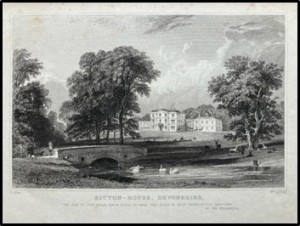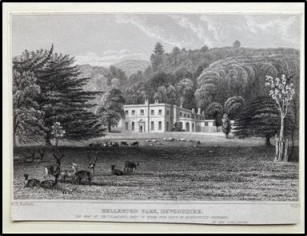
Exotic Plants and Intrepid Collectors:
Veitch, the Devon Years
with Caradoc Doy on Thursday, 10 July 2025
at 7pm at Leonardo Hotel Exeter [Jurys Inn Exeter Hotel]
Neil gave a fulsome introduction to Caradoc Doy - summarised briefly for this write-up as having a passion for plants and plant conservation and a keen interest in gardens and the designed landscape. He trained at Bicton College of Agriculture (1986) and Pershore College of Horticulture (1987-1990) followed by a career with some leading nurseries and garden centres, in particular St Bridget Nurseries in Exeter. Here he became interested in the Veitch family and their contribution to plant exploration and introduction, and this has led to a fascinating study into the Veitch Nurseries of Exeter and Chelsea. He is now a self-employed horticulturist, garden speaker and writer.
When the Scot, John Veitch (1752-1839), arrived in Devon in the late 1700s to lay out the grounds of Killerton, the foundations were laid for the establishment of one of the most remarkable horticultural dynasties in Britain. John’s son, James Veitch Senior (1792-1863), pioneered the sending of his own plant collectors abroad on behalf of his nursery on often dangerous journeys in search of new plants, which was fuelled by the insatiable appetite of the Victorian gardening elite who would pay almost any price for a new exotic novelty. Over a period of 72 years the Veitch family sent 23 plant collectors across the globe in search of new plants.
Five generations of the Veitch family [see family tree on Wikipedia] took charge of the nursery business, which was also involved in advising and creating fine designed landscapes and gardens. They introduced many hundreds of new plants, created the first official orchid hybrid and oversaw the arrival of the Wellingtonia tree.
In this richly illustrated talk Caradoc Doy told the story of this remarkable firm, giving an account of the rise of the Veitch Nurseries from the early days in Exeter, and describing some of the South West landscapes influenced by the Veitches. Quoting from the leaflet handed out by Caradoc about Plant Hunters and Pioneers he writes “This talk is a brief history of a remarkable nursery which sent twenty-three plant collectors to many countries, mainly during the Victorian period. William and Thomas Lobb, Richard Pearce, John Gould Veitch and Peter Veitch, Frederick Burbidge, Charles Maries, Ernest Wilson and others, all worked for the Veitch nurseries of Exeter and Chelsea [and the talk] highlights some of the well-known and interesting varieties introduced by these pioneering plant hunters, who discovered many hundreds of new species. So successful were they that there is scarcely a garden in the British Isles that does not contain a plant derived from their introductions.”
Caradoc’s story began with Sir Thomas Dyke Acland, 7th Baronet (1722-1785), who owned lots of land across Devon and elsewhere and appointed John Veitch from Jedburgh, Scotland, to be the first head gardener and land steward at Killerton. John Veitch gave advice to other estates in all counties of England except Rutland. He was allowed part of the estate for his own nursery at Budlake and Ashclyst at Killerton and was sending his own staff to Luscombe Castle pre-1800. He also gave advice at Nutwell and Escot, and at Escot recommended removing a lane which went through the Escot estate and very close to the house, which proved rather controversial as the lane was used by local residents. Caradoc also listed the various estates in Devon which were influenced by the Veitch family – Bicton, Poltimore, Huntsham Court, Tiverton, Bystock, Stover, Rougemont Gardens rockery, Heavitree Pleasure Ground, Oldway Mansion, Paignton, Manor House, Dawlish, Abbotsbury, Newton Abbot, the grotto at Winterbourne, Teignmouth, Greenway, and Kingswear.
The 10th Baronet Sir Thomas Dyke Acland (1787-1871) commissioned the building known now as the Bear Hut for his wife along with the beech and chestnut walk. James Veitch Senior (1792-1863) was aware of the interest in new plants abroad and the Veitch Nursery branched out into plants other than trees. He had a house built at Gras Lawn in Barrack Road plus another house for James Veitch Junior (1815-1869). He made greenhouses before the repeal of the punitive glass tax which made it possible for the middle classes to own them and not just the landed gentry. Later under Robert Veitch there was a Nursery in New North Road near to Exeter Prison. The Nursery later moved to Alphington under Mildred Veitch, and the firm also rented land at Exwick. There is an Exeter Civic Society blue plaque at No. 11 Elm Grove Road, which reads: “Robert Tosswill Veitch, 1823-1885, Horticulturist and Nurseryman, lived here, 1865-1884.”
Quoting from the Civic Society website (with some amendments from Caradoc) – “Robert Tosswill Veitch was a member of the Veitch family dynasty of pioneering horticulturists who introduced hundreds of new plants and flowers from across the world into people’s gardens, conservatories and homes. Many of them were available from the famous Veitch “Exotic” Nurseries in Exeter run by Robert Veitch after the death of his father, James. Robert Veitch, whose career spanned the middle of the nineteenth century, was influential in making gardening a serious popular pastime. He extended the nurseries to run along New North Road and to cover the area that is now Velwell Road. He bought 11 Elm Grove Road and the adjoining property in 1865. From there, he had direct access to the nurseries which had relocated the previous year. One of his specialities was fruit trees and developing varieties suited to Devon’s climate.
Robert Veitch and Son, garden designers, created the grounds at Streatham Hall, which are now part of Exeter University campus, as well as laying out Exeter’s Higher Cemetery. The firm employed F.W. Meyer, a German garden designer who moved to Exeter, and who also helped to popularise the fashion for domestic rock and water gardens, changing the country’s suburban ‘gardenscape’. Robert Veitch was born at Killerton, near Exeter, and spent time farming in South Africa before returning to England. He died at Torquay in 1885 and is buried in Exeter’s old St Leonard’s Cemetery.”
Caradoc showed an image of 54 High Street [now the Santander section of the shop with cash machines] run by James Veitch and Son 1838-1864, and Robert Veitch and Sons, Seed Warehouse 1864-1930. He also mentioned the move to 17 Cathedral Yard (western half of the Well House) Robert Veitch and Sons Ltd., Seedsmen and Nurserymen, 1930-1982. [For a history of these buildings see St Martin’s Island: An introductory history of forty-two Exeter buildings by Todd Gray and Sue Jackson].
Before the arrival of the railway in Exeter James Veitch Senior used Topsham Wharf to send plants as using road transport was not ideal.
Plant hunters used by the Veitch family were sent all over the world – to Chile, Peru, Bolivia, Japan, South Sea Islands, Australia, Brazil, Java, the Malay Archipelago, Costa Rica, Central America, South America, New Granada, South Sea Islands, Borneo, West Coast of Africa, Colombia, South Africa, Madagascar, Sumatra, Java and the Moluccas, East Indies, Burma, Columbia, India, Malaysia, Korea, and New Zealand [see Wikipedia article for corresponding names of plant hunters – most prominent being the three members of the Veitch family John Gould Veitch, Peter Veitch and James H. Veitch, and Cornish brothers William and Thomas Lobb, Ernest Wilson and Charles Maries]. Some of the plants discovered by them were subsequently named in their honour.
Some of the plant families mentioned by Caradoc included begonias, fuchsias, myrtle, nasturtium, Chilean lantern tree, monkey puzzle, rhododendron, japonica, and [as illustrated on Wikipedia] the Nepenthes rajah (water carrier) but the Veitch company were most famous for their orchid introductions including an orchid hybrid by John Dominy (1816-1891) in Exeter which was controversial at the time. 19 plant collectors introduced orchids.
Caradoc spent some time talking about the Lobb Brothers. William Lobb was sent to Brazil, Chile, Peru and Ecuador, and Thomas Lobb spent the best part of 17 years in the Far East. Caradoc spoke about the plants they discovered. Sadly, Thomas injured his leg which turned gangrenous and had to be amputated. He returned home to Cornwall, became a recluse and spent his time painting orchids.
James Veitch Senior died in 1863, a few days after the death of his wife, and is buried at Broadclyst next to the Acland family plot. James Veitch Junior moved to London and died in 1869. His son Harry James Veitch (1840-1924) was educated in Exeter and went to London to work in his father’s business in Chelsea, James Veitch and Son. He helped organise the Royal International Horticultural Exhibition at the Royal Hospital, Chelsea in 1912. The site proved so popular with the public that, following the show, the Royal Horticultural Society asked to use the site the following year for the 1913 ‘Great Spring Show’ or what we all know today as the Chelsea Flower Show.
He later helped design the gardens at the Royal Hospital Chelsea. Souvenirs in the firm’s museum at Kings’ Road Chelsea were donated to RAMM. The Chelsea side of the business ceased trading in 1914 and James Veitch Junior’s brother Robert Veitch (1823-1885), and Robert’s son Peter Veitch (1850-1929) and Peter’s daughter Mildred Veitch (1889-1971) ran the Exeter branch. Peter Veitch went to New Zealand, but his collection of plants was washed off the deck of the ship he was on. Mildred sold the firm in 1969 to St Bridget Nurseries.
Quoting again from the leaflet Caradoc handed out – “Caradoc has become an authority on the history of the Veitch nurseries and their plant hunters, which led him to re-publish a numbered, limited edition centenary facsimile of Hortus Veitchii by James H. Veitch in 2006. In 2003, he staged a Veitch exhibit at St Bridget Nurseries, Exeter and at the Devon County Show in 2004 which received a Large Gold Medal (on behalf of St Bridget Nurseries).” He was also part of a team which put on an exhibit about the work of Veitch on behalf of the plant conservation charity, Plant Heritage in 2012, to mark the centenary of the Royal International Horticultural Exhibition. They were awarded a Silver Gilt medal and were honoured with a visit from HM Queen Elizabeth II.
This was a very interesting talk with much information on the Veitch family, their plant hunters, and the countless plant varieties they introduced. It is recommended that members look up Caradoc's own website and the Wikipedia article already mentioned for much more detail than it has been possible to record here.
Sue Jackson


